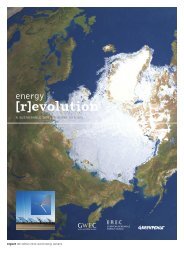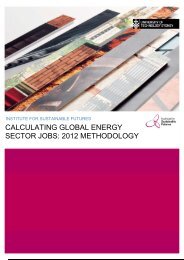download the mexico energy revolution scenario
download the mexico energy revolution scenario
download the mexico energy revolution scenario
Create successful ePaper yourself
Turn your PDF publications into a flip-book with our unique Google optimized e-Paper software.
WORLD ENERGY [R]EVOLUTION<br />
A SUSTAINABLE ENERGY OUTLOOK<br />
8<br />
<strong>energy</strong> technologies | RENEWABLE ENERGY TECHNOLOGIES<br />
renewable <strong>energy</strong> technologies<br />
Renewable <strong>energy</strong> covers a range of natural sources which are<br />
constantly renewed and <strong>the</strong>refore, unlike fossil fuels and uranium,<br />
will never be exhausted. Most of <strong>the</strong>m derive from <strong>the</strong> effect of <strong>the</strong><br />
sun and moon on <strong>the</strong> earth’s wea<strong>the</strong>r patterns. They also produce<br />
none of <strong>the</strong> harmful emissions and pollution associated with<br />
‘conventional’ fuels. Although hydroelectric power has been used on<br />
an industrial scale since <strong>the</strong> middle of <strong>the</strong> last century, <strong>the</strong> serious<br />
exploitation of o<strong>the</strong>r renewable sources has a more recent history.<br />
solar power (photovoltaics) There is more than enough solar<br />
radiation available all over <strong>the</strong> world to satisfy a vastly increased<br />
demand for solar power systems. The sunlight which reaches <strong>the</strong><br />
earth’s surface is enough to provide 2,850 times as much <strong>energy</strong> as<br />
we can currently use. On a global average, each square metre of land<br />
is exposed to enough sunlight to produce 1,700 kWh of power every<br />
year. The average irradiation in Europe is about 1,000 kWh per square<br />
metre, however, compared with 1,800 kWh in <strong>the</strong> Middle East.<br />
Photovoltaic (PV) technology involves <strong>the</strong> generation of electricity<br />
from light. The essence of this process is <strong>the</strong> use of a semiconductor<br />
material which can be adapted to release electrons, <strong>the</strong> negatively<br />
charged particles that form <strong>the</strong> basis of electricity. The most common<br />
semiconductor material used in photovoltaic cells is silicon, an<br />
element most commonly found in sand. All PV cells have at least two<br />
layers of such semiconductors, one positively charged and one<br />
negatively charged. When light shines on <strong>the</strong> semiconductor, <strong>the</strong><br />
electric field across <strong>the</strong> junction between <strong>the</strong>se two layers causes<br />
electricity to flow. The greater <strong>the</strong> intensity of <strong>the</strong> light, <strong>the</strong> greater<br />
<strong>the</strong> flow of electricity. A photovoltaic system does not <strong>the</strong>refore need<br />
bright sunlight in order to operate, and can generate electricity even<br />
on cloudy days. Solar PV is different from a solar <strong>the</strong>rmal collecting<br />
system (see below) where <strong>the</strong> sun’s rays are used to generate heat,<br />
usually for hot water in a house, swimming pool etc.<br />
The most important parts of a PV system are <strong>the</strong> cells which form<br />
<strong>the</strong> basic building blocks, <strong>the</strong> modules which bring toge<strong>the</strong>r large<br />
numbers of cells into a unit, and, in some situations, <strong>the</strong> inverters<br />
used to convert <strong>the</strong> electricity generated into a form suitable for<br />
everyday use. When a PV installation is described as having a<br />
capacity of 3 kWp (peak), this refers to <strong>the</strong> output of <strong>the</strong> system<br />
under standard testing conditions, allowing comparison between<br />
different modules. In central Europe a 3 kWp rated solar electricity<br />
system, with a surface area of approximately 27 square metres,<br />
would produce enough power to meet <strong>the</strong> electricity demand of an<br />
<strong>energy</strong> conscious household.<br />
There are several different PV technologies and types of installed system.<br />
technologies<br />
• crystalline silicon technology Crystalline silicon cells are made<br />
from thin slices cut from a single crystal of silicon (mono<br />
crystalline) or from a block of silicon crystals (polycrystalline or<br />
multi crystalline). This is <strong>the</strong> most common technology,<br />
representing about 80% of <strong>the</strong> market today. In addition, this<br />
technology also exists in <strong>the</strong> form of ribbon sheets.<br />
• thin film technology Thin film modules are constructed by<br />
depositing extremely thin layers of photosensitive materials onto<br />
92<br />
a substrate such as glass, stainless steel or flexible plastic. The<br />
latter opens up a range of applications, especially for building<br />
integration (roof tiles) and end-consumer purposes. Four types of<br />
thin film modules are commercially available at <strong>the</strong> moment:<br />
Amorphous Silicon, Cadmium Telluride, Copper Indium/Gallium<br />
Diselenide/Disulphide and multi-junction cells.<br />
• o<strong>the</strong>r emerging cell technologies (at <strong>the</strong> development or early<br />
commercial stage): These include Concentrated Photovoltaic,<br />
consisting of cells built into concentrating collectors that use a<br />
lens to focus <strong>the</strong> concentrated sunlight onto <strong>the</strong> cells, and Organic<br />
Solar Cells, whereby <strong>the</strong> active material consists at least partially<br />
of organic dye, small, volatile organic molecules or polymer.<br />
systems<br />
• grid connected The most popular type of solar PV system for<br />
homes and businesses in <strong>the</strong> developed world. Connection to <strong>the</strong><br />
local electricity network allows any excess power produced to be<br />
sold to <strong>the</strong> utility. Electricity is <strong>the</strong>n imported from <strong>the</strong> network<br />
outside daylight hours. An inverter is used to convert <strong>the</strong> DC<br />
power produced by <strong>the</strong> system to AC power for running normal<br />
electrical equipment.<br />
• grid support A system can be connected to <strong>the</strong> local electricity network<br />
as well as a back-up battery. Any excess solar electricity produced after<br />
<strong>the</strong> battery has been charged is <strong>the</strong>n sold to <strong>the</strong> network. This system is<br />
ideal for use in areas of unreliable power supply.<br />
• off-grid Completely independent of <strong>the</strong> grid, <strong>the</strong> system is<br />
connected to a battery via a charge controller, which stores <strong>the</strong><br />
electricity generated and acts as <strong>the</strong> main power supply. An<br />
inverter can be used to provide AC power, enabling <strong>the</strong> use of<br />
normal appliances. Typical off-grid applications are repeater<br />
stations for mobile phones or rural electrification. Rural<br />
electrification means ei<strong>the</strong>r small solar home systems covering<br />
basic electricity needs or solar mini grids, which are larger solar<br />
electricity systems providing electricity for several households.<br />
• hybrid system A solar system can be combined with ano<strong>the</strong>r<br />
source of power - a biomass generator, a wind turbine or diesel<br />
generator - to ensure a consistent supply of electricity. A hybrid<br />
system can be grid connected, stand alone or grid support.<br />
figure 9.1: photovoltaics technology<br />
1<br />
2<br />
3<br />
4<br />
5<br />
6<br />
7<br />
1. LIGHT (PHOTONS)<br />
2. FRONT CONTACT GRID<br />
3. ANTI-REFLECTION COATING<br />
4. N-TYPE SEMICONDUCTOR<br />
5. BOARDER LAYOUT<br />
6. P-TYPE SEMICONDUCTOR<br />
7. BACKCONTACT



![Energy [R]evolution - European Commission](https://img.yumpu.com/49109324/1/184x260/energy-revolution-european-commission.jpg?quality=85)


![5905 gp [eu rev]csfr4.qxd - Energy [R]evolution](https://img.yumpu.com/42305023/1/184x260/5905-gp-eu-revcsfr4qxd-energy-revolution.jpg?quality=85)


![5905 gp [eu rev]csfr4.qxd - Energy [R]evolution](https://img.yumpu.com/28729264/1/184x260/5905-gp-eu-revcsfr4qxd-energy-revolution.jpg?quality=85)